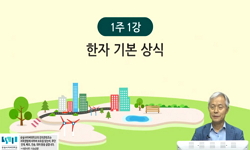This paper is an attempt to show the possibility and potentiality of Chinese Characters by tracing the process of their creation by the ancients before the foundation of classical learning and the elaboration of the technology of power in China. Accor...
http://chineseinput.net/에서 pinyin(병음)방식으로 중국어를 변환할 수 있습니다.
변환된 중국어를 복사하여 사용하시면 됩니다.
- 中文 을 입력하시려면 zhongwen을 입력하시고 space를누르시면됩니다.
- 北京 을 입력하시려면 beijing을 입력하시고 space를 누르시면 됩니다.

고대 중국인의 문자관- 한자의 잠재성과 가능성 = Thinking through ‘wén ’(文) and ‘zì ’(字): The Possibility and Potentiality of Chinese Characters
한글로보기부가정보
다국어 초록 (Multilingual Abstract)
This paper is an attempt to show the possibility and potentiality of Chinese Characters by tracing the process of their creation by the ancients before the foundation of classical learning and the elaboration of the technology of power in China.
According to Xu Shen’s(許愼) Shuōwén Jiězì(說文解字), the oldest and one of the most important character dictionaries of ancient China, Chinese did not consider their writing system as a secondary sign system serving the sole purpose of representing vocal speech. Xu Shen draws a basic distinction between two types of characters, wén(文) and zì(字). Wén is those composed of a single graphic element and zì those containing more than one such element. Both terms are combined to the word, wénzì(文字) meaning Chinese character.
Relying on the distinction, I would like to develop new ideas and concepts on Chinese writing in this paper. Firstly, ‘wén’(文) represents the great intellect of such a saint who does not have any interest in secular profit and interest, as Cang Jie(倉頡) who is known as a creator of Chinese characters. Chinese character invention was such a great event that could changes the rules of the situation. As he made the insensible sensible and the invisible visible in the process of creating Chinese characters, it is said the millet fell down like rain from heaven, and ghost cried during the night. In addition to the detailed interpretation of the myth, I try to investigate the singular sense of the word as a truth event, analyzing the etymological sense ‘wén’ in Oracle bone inscriptions more specifically. On the other hand, through compound characters called ‘zì’, I try to expose non-hierarchical and democratic properties of writing. Finally, I attempt to suggest a way of looking at the world through wénzì which is meant to be both destabilising and, at the same time, productive of new ideas.
참고문헌 (Reference)
1 프레이저, "황금가지" 을유문화사 2005
2 조르조 아감벤, "호모 사케르" 새물결 2008
3 고인덕, "한자의 세계-중국문화의 원점-" 솔출판사 2008
4 河永三, "한자의 세계 : 기원에서 미래까지" 늘함께 1998
5 하영삼, "한자와 에크리튀르" 아카넷 2011
6 김근, "한자는 중국을 어떻게 지배했는가?" 민음사 1999
7 白川靜, "한자 백가지 이야기" 황소자리 2005
8 리차드 할랜드, "초구조주의란 무엇인가" 현대미학사 1996
9 하영삼, "진리의 근원: “眞”의 字源考" 중국인문학회 (43) : 19-49, 2009
10 미셀 푸코, "지식의 고고학" 민음사 2000
1 프레이저, "황금가지" 을유문화사 2005
2 조르조 아감벤, "호모 사케르" 새물결 2008
3 고인덕, "한자의 세계-중국문화의 원점-" 솔출판사 2008
4 河永三, "한자의 세계 : 기원에서 미래까지" 늘함께 1998
5 하영삼, "한자와 에크리튀르" 아카넷 2011
6 김근, "한자는 중국을 어떻게 지배했는가?" 민음사 1999
7 白川靜, "한자 백가지 이야기" 황소자리 2005
8 리차드 할랜드, "초구조주의란 무엇인가" 현대미학사 1996
9 하영삼, "진리의 근원: “眞”의 字源考" 중국인문학회 (43) : 19-49, 2009
10 미셀 푸코, "지식의 고고학" 민음사 2000
11 손예철, "중국문자학" 아카넷 2003
12 가라타니 고진, "언어와 비극" 도서출판b 2004
13 K-C. Chang, "신화, 미술, 제사" 동문선 1990
14 하영삼, "문화적 관념이 한자 해석에 미치는 원리-『第五游』의 字釋을 통해 본 沈有鎮의 政治意識" 대한중국학회 (40) : 87-115, 2011
15 미셀 푸코, "말과 사물" 민음사 1986
16 Foucault, Michel, "말과 사물" 민음사 1986
17 루이 옐름슬레우, "랑가쥬 이론 서설" 동문선 2000
18 楊昇南, "깁골학일백년" 소명출판사 2012
19 Derrida, Jaques, "그라마톨로지에 대하여" 동문선 2004
20 Ong, Walter J, "구술문화와 문자문화" 문예출판사 1995
21 Lewis, "고대 중국의 글과 권위" 미토 2006
22 Françoise Bottéro, "論許慎字形分析的一些特點" 한국한자연구소 (8) : 1-28, 2013
23 陸宗達, "說文解字通論" 1994
24 丁福保, "說文解字詁林" 鼎文書局 1983
25 臧克和, "說文解字的文化說解" 湖北人民出版社 1995
26 許愼, "說文解字注" 漢京文化事業公司 1983
27 臧克和, "說文解字新訂" 中華書局 2002
28 河永三, "第五游整理與硏究" 上海人民出版社 2012
29 Saussure, Ferdinand De, "第三次普通語言學敎程" 上海人民出版社 2002
30 孟華, "漢語和華夏文明的內在形式" 中國社會科學出版社 2004
31 臧克和, "漢字單位觀念史考述" 學林出版社 1998
32 Saussure, Ferdinand De, "普通語言學敎程" 商務印書館 2002
33 孟華, "文字論" 山東敎育出版社 2008
34 古文字詁林編纂委員會, "古文字詁林" 上海敎育出版社 1999
35 黃亞平, "典籍符號與權力話語" 中國社會科學出版社 2004
36 白川靜, "中國古代文化" 文津出版社 1983
37 하영삼, "“鬼” 系列 漢字群의 字源으로 살펴본 古代 中國人들의 鬼神 認識" 영남중국어문학회 (50) : 405-452, 2007
38 河永三, "‘言’과 ‘文’ 系列 漢字群의 字源을 通해 본 中國의 文字中心의 象徵體系" 한국중어중문학회 (38) : 1-35, 2006
39 Beattie, James, "The Theory of Language" Nationalism and Language Reform in China
40 Rancière, Jacques, "The Flesh of Words: The Politics of Writing" Stanford UP 2004
41 Wilson, Edward, "Sociobiology: The New Synthesis" Belknap P of Harvard UP 1975
42 Bottéro, Françoise, "Revisiting the wén文 and the zì字: The Great Chinese Characters Hoax" (74) : 2002
43 Ong, Walter J, "Ramus, Method, and the Decay of Dialogue" Harvard UP 1958
44 Rancière, Jacques, "Mute Speech: Literature, Critical Theory, and Politics" Columbia UP 2011
45 Russell, Bertrand, "An Outline of Philosophy" Routledge 1927
동일학술지(권/호) 다른 논문
-
- 한국중국언어문화연구회
- 김수연
- 2013
- KCI등재
-
朝鮮刊本 <樊川文集夾註> 인용서적의 문헌가치에 관한 再論
- 한국중국언어문화연구회
- 김호
- 2013
- KCI등재
-
历史变迁中的民间文化记忆——读中国重庆土家族作家吴加敏长篇小说《花灯》
- 한국중국언어문화연구회
- 张羽华
- 2013
- KCI등재
-
- 한국중국언어문화연구회
- 裴春芳
- 2013
- KCI등재
분석정보
인용정보 인용지수 설명보기
학술지 이력
| 연월일 | 이력구분 | 이력상세 | 등재구분 |
|---|---|---|---|
| 2023 | 평가예정 | 재인증평가 신청대상 (재인증) | |
| 2020-01-01 | 평가 | 등재학술지 선정 (재인증) |  |
| 2018-01-01 | 평가 | 등재후보학술지 선정 (신규평가) |  |
| 2017-12-01 | 평가 | 등재후보 탈락 (계속평가) | |
| 2016-12-01 | 평가 | 등재후보로 하락 (계속평가) |  |
| 2013-04-03 | 학회명변경 | 한글명 : 한국현대중국연구회 -> 한국중국언어문화연구회영문명 : Korea Research Center For China -> Korean Society of Study on Chinese Languge and Culture |  |
| 2013-04-03 | 학술지명변경 | 한글명 : 韓中言語文化硏究 -> 한중언어문화연구 |  |
| 2012-01-01 | 평가 | 등재학술지 선정 (등재후보2차) |  |
| 2011-01-01 | 평가 | 등재후보 1차 PASS (등재후보1차) |  |
| 2010-01-01 | 평가 | 등재후보학술지 유지 (등재후보2차) |  |
| 2009-01-01 | 평가 | 등재후보 1차 PASS (등재후보1차) |  |
| 2008-01-01 | 평가 | 등재후보학술지 유지 (등재후보1차) |  |
| 2006-01-01 | 평가 | 등재후보학술지 선정 (신규평가) |  |
학술지 인용정보
| 기준연도 | WOS-KCI 통합IF(2년) | KCIF(2년) | KCIF(3년) |
|---|---|---|---|
| 2016 | 0.06 | 0.06 | 0.05 |
| KCIF(4년) | KCIF(5년) | 중심성지수(3년) | 즉시성지수 |
| 0.04 | 0.03 | 0.199 | 0.02 |




 KCI
KCI






